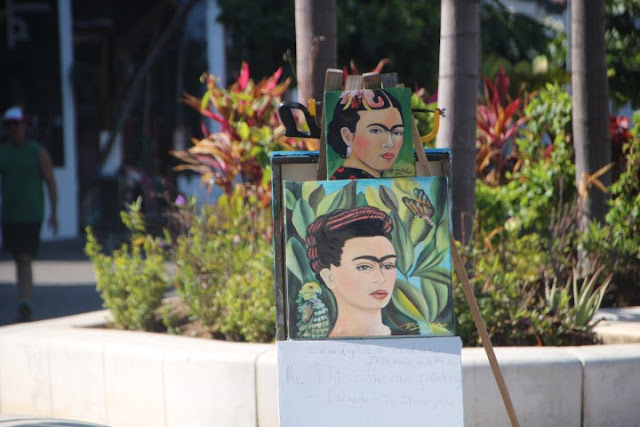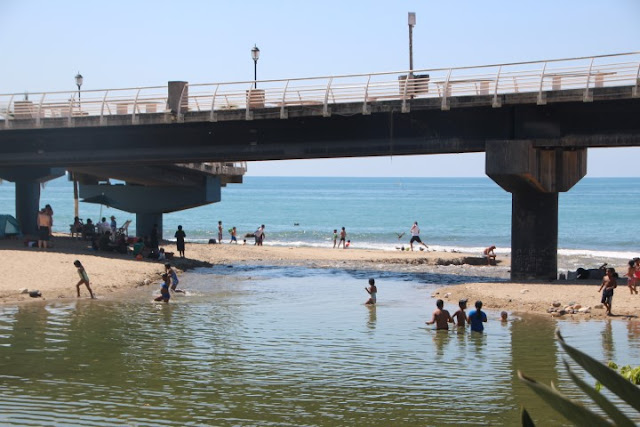March 2016 - Puerto Vallarta Mexico
Friday we headed to the market but before we got there we got dropped off at Hotel Rosita and another stroll along the malecon just as we have in our last couple of walks.
Another peek into the Hotel Rosita lobby.
Senora Peggy Pelican doing her Friday shopping at the fish market.
A new sand sculpture.
Still more Frida.
Still screaming with a song.
Very crabby.
Hey, meester, you want more junk? We often hear this as we walk through the markets.
Art on a cafe wall.
No, we haven't reached the market yet, we are meandering the streets around Rio Cuale.
Hotel Catedral.
Another catrina in the restaurant of the Hotel Catedral.
The Huichol or Wixáritari (Huichol pronunciation: /wiˈraɾitaɾi/) are Native Mexicans, living in the Sierra Madre Occidental range in the Mexican states of Nayarit, Jalisco, Zacatecas, and Durango.
Descendents of the Aztec, the Huichol number about 18,000, most of whom live in the sierra of Jalisco and Nayarit. Having withstood the Spanish Invasion, they are still striving to keep their culture alive and viable, despite the ever increasing physical and cultural encroachment of their Mexican neighbors. Peyote is a focal point for their ceremonies, and their colorful beadwork and yarn work reflects a reverent and symbiotic relationship with nature.
The Huichol people are a culture in transition as modern life encroaches upon their traditional ways. Many have migrated to cities such as Tepic and Guadalajara; others struggle with poverty, land-invasion and illness caused by pesticides in tobacco plantations where many find work as day laborers. Few outsiders are welcome in Huichol villages located in the high sierra.
We had been eyeing their masks for a while and had inquired in several places about the prices.
I showed a few photos from another shop here.
Why is Puerto Vallarta a famous tourist destination today? There are many reasons, but there in the Top 10 main reasons are three names: John Huston, Elizabeth Taylor and Richard Burton.
During 1963, a famous love story culminated when John Huston arrived in the small fisherman harbor to film his 25th movie and Burton and Taylor, plus many other stars arrived too.
Last week I showed the statue of John Huston.
The market.
Enough, time for lunch.
We choose Oscar's and have a table with a view and notice there is a wedding chapel set up.
The priest is giving instructions to the groom.
The bride and her father arrive.
The groom and his mother.
Here comes the bride.
Oblivious to the wedding.
The “Lazo” is a sort of tied rope which can be made from something as simple as a ribbon, to something as ornate as a rosary – either beaded or jeweled, silver filigree, crystals, satin or wreath of orange blossoms, fertility symbols- to symbolically join the bride and groom . It is placed around the necks of the couple – in a figure 8- after they have exchanged their vows to represent their linked future together; the joining of two lives. It’s also called a “UNITY LACE”. Usually, family of the bride & groom, padrinos or best friends of the couple are the ones responsible for “lassoing” the Bride and Groom together. Tradition requires the couple to wear the lasso for the remainder of the service.
The woman who owned this shop was very knowledgable and said that if we gave her an email address she would provide more information about their culture. By the time we got back I had already received the email.
Yes, we chose a mask at a good price.
I showed a few photos from another shop here.
Why is Puerto Vallarta a famous tourist destination today? There are many reasons, but there in the Top 10 main reasons are three names: John Huston, Elizabeth Taylor and Richard Burton.
During 1963, a famous love story culminated when John Huston arrived in the small fisherman harbor to film his 25th movie and Burton and Taylor, plus many other stars arrived too.
Last week I showed the statue of John Huston.
The market.
Enough, time for lunch.
We choose Oscar's and have a table with a view and notice there is a wedding chapel set up.
The priest is giving instructions to the groom.
The bride and her father arrive.
The groom and his mother.
Here comes the bride.
Oblivious to the wedding.
The “Lazo” is a sort of tied rope which can be made from something as simple as a ribbon, to something as ornate as a rosary – either beaded or jeweled, silver filigree, crystals, satin or wreath of orange blossoms, fertility symbols- to symbolically join the bride and groom . It is placed around the necks of the couple – in a figure 8- after they have exchanged their vows to represent their linked future together; the joining of two lives. It’s also called a “UNITY LACE”. Usually, family of the bride & groom, padrinos or best friends of the couple are the ones responsible for “lassoing” the Bride and Groom together. Tradition requires the couple to wear the lasso for the remainder of the service.
You can see the white lasso with flowers around the couple.
Washroom sign,
Another rope bridge.
What is he shooting?
Yet another view of the church.
Time to head back.

Washroom sign,
What is he shooting?
Yet another view of the church.
Time to head back.

















































It's just a gorgeous place -- and all that art (and crafts). Love the colors. How fun that you saw a wedding.
ReplyDeleteSo much colour and excitement! I can tell you are a shopper, Jackie :) Isn't that a lovely custom with the bride and groom? I love the name Rosita but that balcony at the Cathedral hotel had my name all over it! :) Many thanks for joining me again, Jackie. Enjoy your last week in Mexico!
ReplyDeleteA nice thing to see a wedding going on. That pelican looks like quite a character!
ReplyDeleteI really enjoyed reading this post and viewing the photographs of Mexico.Very colorful and exciting views...
ReplyDeleteAll the art there is really amazing.. not just the paintings but the textiles as well. Mexico is a vibrant display of color, that is for sure.
ReplyDeleteLisa @ Life Thur the Lens
Very interesting walk, very inspiring - very well captured.
ReplyDeleteStriking colours and bright blue skies! Looks like the perfect place to do a some leisurely exploring.
ReplyDelete